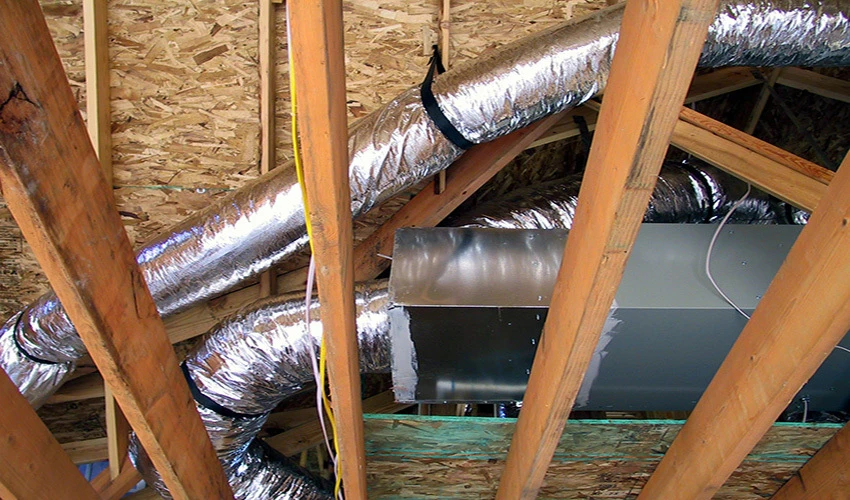Is Wrapping Ductwork to Prevent Condensation Effective?

Yes! wrapping your ductwork will reduce condensation on residential air ducts. If you’ve noticed droplets of water forming on your ductwork lately, it’s time to have a conversation about condensation on ductwork: what it is, what causes it, and what it can do to your HVAC system.
Long story short, it’s time to insulate your ducts.
First, Why Are My Air Ducts Sweating?
If your ductwork is starting to look like a cold soda bottle on a hot summer day, you’ve got condensation. Condensation—the tiny beads of water forming on your ductwork—is simply water from the air that has converted to its liquid state.
Condensation occurs for a few reasons. When there’s a big temperature difference between the cool air inside your AC ducts and the warmer air outside of them, water vapor cools and collects on the surface of the ductwork. The hotter the summer gets, the worse the effect.
Condensation can also be caused by excess moisture in the air (high indoor humidity), or a dirty HVAC air filter- which may restrict airflow or even trap water vapor within.
Why Is Condensation on Air Ducts Problematic?
Condensation on air ducts can become a big problem for your AC system over time. The buildup of moisture in your crawl spaces and ductwork can attract mold and reduce your air quality. Water can start to drip onto your ceilings, causing water stains and structural damage.
Luckily, there are a lot of things you can do to prevent these problems.
HVAC Problems: The Root of Condensation on Air Ducts
First, rule out mechanical problems with your HVAC system that could be responsible for the condensation.
Here’s an easy checklist to help troubleshoot any condensation-causing HVAC problem:
- Listen for strange noises that might indicate a broken fan.
- Smell your ductwork. Yes, you heard us right. A new or foul odor might indicate a blockage or a dirty filter.
- If you feel less airflow than usual, try cleaning or replacing your air filter.
- Check for leaks. You may be able to feel air leaking out of a duct with your hand, or with the help of a pressure gauge.
If the airflow problem persists, you may have a dirty evaporator coil or the system could be low on refrigerant causing the coil to ice over causing excess drainage. If the condensation seems to be caused by a mechanical issue, it’s time to troubleshoot the problem or contact your local Aire Serv for professional assistance.
How Do You Stop Condensation on Air Conditioning Ducts?
Once you’ve ruled out a mechanical or other HVAC issues, consider insulating your metal ductwork. Uninsulated or poorly insulated metal ducts are often the culprit. Insulation prevents warm air outside the ducts from contacting cool, metal ductwork, thereby preventing condensation. Duct wrap, which is insulation made especially for insulating ducts, has an inner layer of foam or fiberglass and an outer layer of foil.
To insulate your ducts, you’ll need the following gear, along with your insulation:
- Protective goggles
- Metallic foil duct tape
- Dust mask
- Straight edge or carpenter’s square
- Utility knife
Wrapping Duct Work to Prevent Condensation
Wrapping ductwork to prevent condensation is a common mitigation step.
Here’s how:
- Measure your insulation.
Wrap the material around your ducts and mark where you’ll need to cut for a snug fit. Make sure the fit isn’t so tight that the insulation layer will be compressed. - Cut the insulation.
Using your straight edge or carpenter’s square as a guide, cut the insulation with a utility knife. - Clean and apply the insulation.
Wipe down the foil edges of the insulation so that duct tape will apply cleanly later. Apply small pieces of tape as you go to hold the wrapping in place. - Seal insulation with tape.
Remove the paper backing from the duct tape as you apply it to prevent it from sticking to itself. Seal the length of each wrapping piece with a long piece of duct tape. Seal joints by wrapping tape all the way around. - Inspect.
Check for gaps and seal everything with tape.
Still worried about excess moisture around your HVAC ducts? Help your system out by installing a dehumidifier in your attic or crawlspace. Or have your ducts spaced out farther apart to promote airflow. And, of course, replace your air filters and get your ducts cleaned regularly.
Keep Your AC System Working Smoothly with Help from Aire Serv
Still concerned about your air ducts? From condensation to dirty ducts, we’ve got you covered. Breathe easy with help from Aire Serv®. Call (855) 512-2886 or request an appointment online, today.
 Click to call
Click to call


